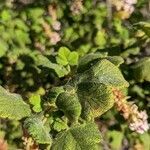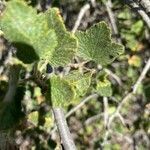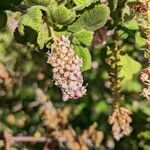Plants 1-2 m. Stems erect, tomentose with gland-tipped, bristly hairs; spines at nodes absent; prickles on internodes absent. Leaves: petiole 1-5 cm, pubescent and stipitate-glandular; blade roundish, 3-5-lobed, cleft nearly 1/4 to midrib, 2-6 cm, base deeply cordate, surfaces stipitate-glandular, glands colorless, and tomentose abaxially, rough-hairy adaxially, (dark green and rugose), lobes deltate, margins biserrate, apex obtuse. Inflorescences pendent, 10-25-flowered racemes, 3-5 cm, axis stipitate-glandular, flowers evenly spaced. Pedicels jointed, 1-2 mm, pubescent, stipitate-glandular; bracts oblanceolate or wider, 6-9 mm, pubescent, stipitate-glandular. Flowers: hypanthium pink, narrowly tubular-urceolate, 5-8 mm, stipitate-glandular abaxially, villous-pubescent adaxially; sepals nearly overlapping at base, spreading, pink to purple, obovate, (1.5-)4-6 mm; petals nearly connivent, erect, pink to white, oblong-elliptic, not conspicuously revolute or inrolled, 2-3 mm; nectary disc not prominent; stamens nearly as long as petals; filaments broader toward base, 0.6 mm, glabrous; anthers white, ovate, 1.2-1.3 mm, apex minutely apiculate; ovary densely stipitate-glandular; styles connate nearly to stigmas, 6-7 mm, sparsely hairy. Berries palatable, purple, globose, 6-7 mm, hairs glandular.
More
A shrub. It grows 2 m tall. It does not have thorns. The leaves have soft grey hairs underneath. The leaves are 5 cm across and have 3 lobes. They are dull green. The flowers are pink or purple in hanging groups. The fruit are purple to black and sticky.



